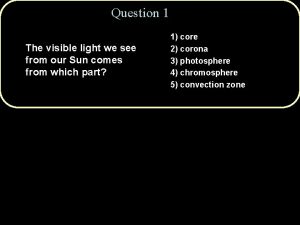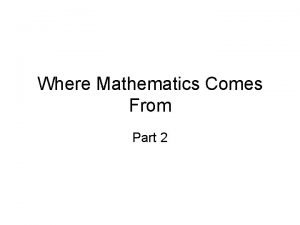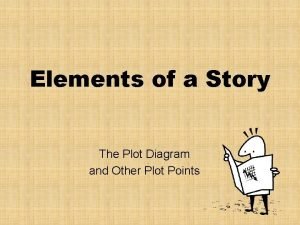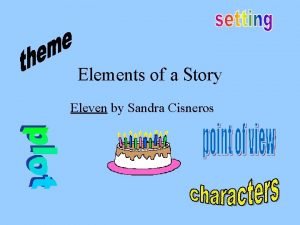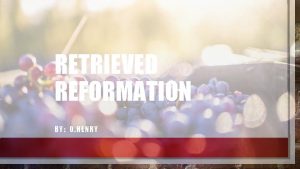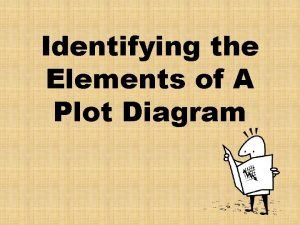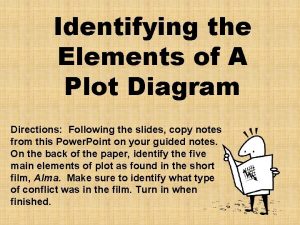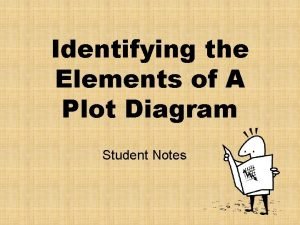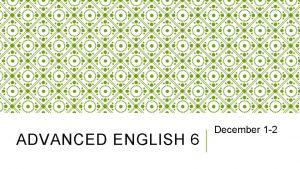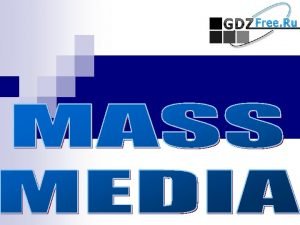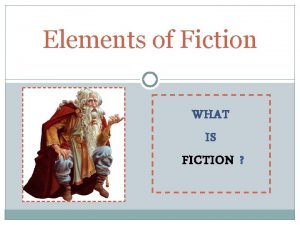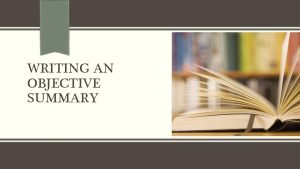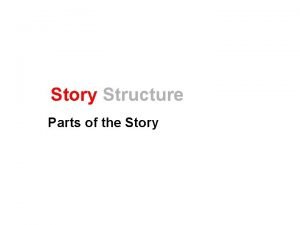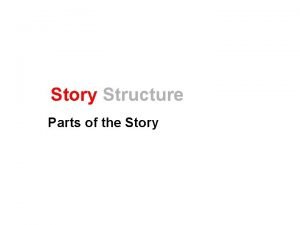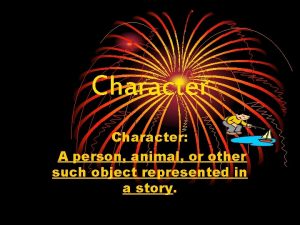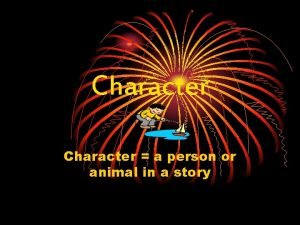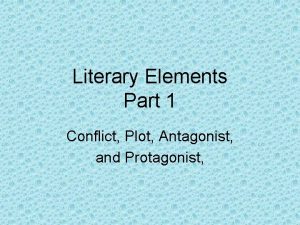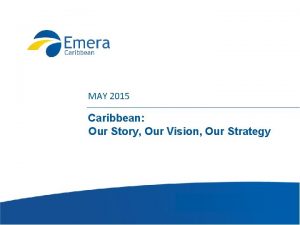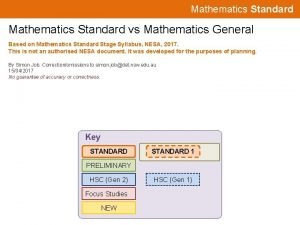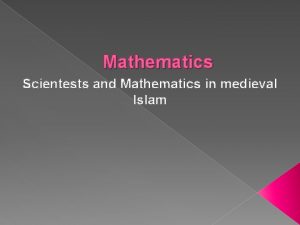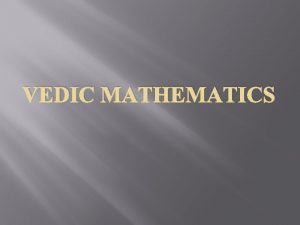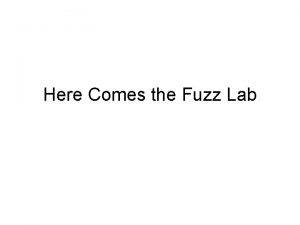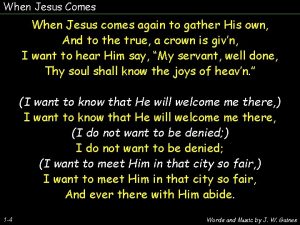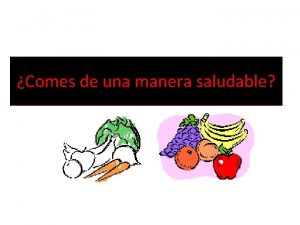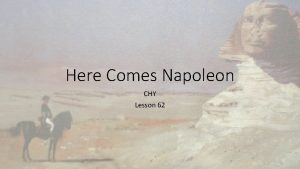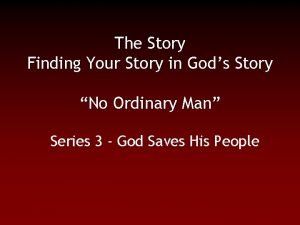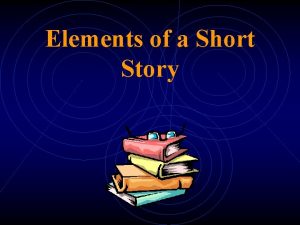Where Mathematics Comes From Part 2 Our Story










































- Slides: 42

Where Mathematics Comes From Part 2

Our Story So Far. . . • We have been building toward a theory of where mathematics comes from. – It builds on the work of several scholars in several areas, including archeology, anthropology, cognitive science, psychology, neuroscience, and linguistics – The major thesis is that mathematics is a human creation with roots in biology and psychology, not in transcendent truth.

The Argument • Humans, for whatever reason, have an inborn ability to deal with (small) quantities. This ability the result of specialized neural pathways in the brain (the Number Module which gives us Number Sense) • Evidence: – – – Animals, Infants History Brain Studies Anthropological Studies Linguistics

The Argument • The abilities of the Number Module are amplified and extended by various cognitive tools. – One of these is the ability to count, which depends on learning some socially transmitted system. – Another is the use of various cognitive mechanisms (metaphorizing and conceptual blending) employed by our embodied minds.

Counting • We (I? ) don’t know as much about the neural or cognitive mechanisms of counting. However, we can talk about what needs to happen in order for children to be able to count correctly. • (Taken from Fuson, Steffe & Cobb, Gallistel & Gelman)

Counting Principles Gallistel and Gelman describe five counting principles that must be followed for successful counting: – – – The One-One Principle: The items being counted must be matched with number words in such a way that one and only one number word is used for each item in the collection. The Stable Order Principle: Number words being matched with objects must be said in the correct order. The Cardinal Principle: The last counting word said in the matching process names the cardinality of the collection. The Abstraction Principle: Counting can be performed on any collection of objects or events, even abstract ones. The Order-Irrelevance Principle: The order in which objects are matched with counting words is irrelevant.

One-One Principle • Establishing the one-to-one correspondence between number words and objects usually involves an indicating act, like pointing, that connects a number word with an object. For example, pointing at an object at the same time as I say “two” establishes the connection between the object and the word. Fuson notes that there actually two one-to-one correspondences involved: One between counting words and indicating acts, and one between indicating acts and objects. Failures in establishing these correspondences result in various kinds of counting errors children make (e. g. skipping an object, counting it twice, matching two or more objects with the same number word).

For counting to be correct, (a) each indicating act must be directed toward an object, (b) each indicating act must not be directed toward more than one object, (c) every object must be indicated, and (d) no object can be indicated more than once. Satisfying (c) and (d) requires a way of remembering what has been counted. Objects. . . Keeping track by (a) “marking” individual counted objects so that it is clear that the object has been counted (moving objects from an uncounted to a counted pile; pointing in which each object is physically or mentally “marked” as the object is counted) and (b) using a linear ordering on the objects. One-to-one Correspondence (in space) One-to-one Correspondence Indicating acts: (a) moving objects from a pile of uncounted objects to a pile of counted objects or (b) some variation of pointing at unmoved objects, including the later internalization of pointing as eye fixation “One” “Two” “Three”. . . Number Word Sequence One-to-one Correspondence (in time) “One” “Two” “Three”. . . Number Word Sequence For counting to be correct, (a) one word must correspond to one indicating act, (b) one indicating act must correspond to one word and (c) the words must come from the standard number-word sequence

One-One Principle • There are various indicating acts, including moving objects, marking them, pointing to them, or just looking at each in turn with your eyes. These acts typically insure that all objects get counted and none get counted twice. In order to accomplish this, the indicating acts often serve to partition the objects being counted into two sets – those that have already been counted, and those yet to be counted. Lining up objects to establish a linear order can also help establish such a partition.

Stable Order Principle • This involves learning the counting words in order (probably stored verbally, like a song). • Reciting the counting number sequence may not be stable for young children – they may repeat words, skip others, get still others out of order. However, most children don’t have difficulty with this by the time they enter elementary school.

The Cardinal Principle • Some researchers believe this is learned by counting small groups of items and recognizing that the last number in the sequence is the same as what they get by subitizing. Others believe it is learned as a rule or convention.

The Abstraction Principle • Steffe and Cobb believe that children progress from being able to count (a) physical objects in plain sight, to (b) hidden physical objects, to (c) physical actions such as pointing, tapping, or raising a finger, to (d) verbalizations (such as number words themselves), to (e) whatever they can imagine. • If children do not learn how to count abstract entities, like counting words, they cannot “double count” which forms the basis for solving a wide variety of problems.

Perceptual Unit Items (Objects) Figural Unit Items (Hidden Objects) Motor Unit Items (Gestures, Pointing, Tapping, Raising Fingers) Verbal Unit Items (Number Word Sequence) Hidden . . . One-to-one Correspondence “One” “Two” “Three”. . . Number Word Sequence Children’s initial ability to make countable items involves locating a collection of items in their perceptual field and taking each item as a unit to be counted. . One-to-one Correspondence “One” “Two” “Three”. . . Number Word Sequence One of the first manifestations of independence from immediate perception occurs when a collection of items is counted, even though it is not within the child range of immediate perception or action. . One-to-one Correspondence “Six” “Seven” “Eight”. . . One-to-one Correspondence “Three” “Four” “Five”. . . One Number Word Sequence (Non-Verbal) The essential feature of counting motor unit items is that the child uses the motor act as a substitute for either the perceptual unit item or its figural representative. . [U]nit items are created from the motor components of counting acts. Two Three. . . When the utterance itself signifies a unit item. . . , it becomes a substitute for the countable item. In this case we say that the child counts verbal unit items. Abstract Unit Items: When the items that are counted are no longer necessarily sensory-motor items, that is, not perceptual, motor, nor verbal, the child is said to be counting abstract unit items. At this stage, "nine" represents the sequence “ 1, 2, 3, . . . 9” as well as the items that are coordinated with the sequence.

Order-Irrelevance Principle Understanding this could be the basis for some understandings about arithmetic, e. g. commutativity and associativity.

On to Arithmetic • We know from extensive studies that, at least in our culture, there is a natural progression in the way children learn to do arithmetic. It moves from direct modeling and “counting all” to counting (counting down, counting on from larger) to use of derived facts and recall of facts. So the argument goes that arithmetic is based in counting, and counting is based (at least in part) in our “number sense.

Arithmetic and Beyond Enter Lakoff and Núñez. George Lakoff is a linguist and cognitive psychologist who has helped pioneer work in metaphor and embodied cognition. Rafael Núñez is a psychologist who has done extensive work in embodied cognition and psychology.

Lakoff and Núñez Their argument, as summarized by Núñez: • That the nature of mathematics is about human ideas, not just formal proofs, axioms, and definitions • That these ideas are grounded in speciesspecific everyday cognitive and bodily mechanisms, therefore making mathematics a human enterprise, not a platonic and transcendental entity.

Lakoff and Núñez • That because of this grounding, mathematical ideas are not arbitrary, that is, they are not the product of purely social and cultural conventions • That the conceptual (and idea) structure that constitutes mathematics can be studied empirically, through scientific methods. • That a particular methodology based on embodied cognitive science — Mathematical Idea Analysis — can serve this purpose.

Embodied Cognitive Science • The embodiment of mind. The detailed nature and dynamics of our bodies, our brains, and our everyday functioning in the world structures human concepts and human reason. This includes mathematical concepts and mathematical reason.

Embodied Cognitive Science • The cognitive unconscious. Most cognitive processes are unconscious— not repressed in the Freudian sense, but simply inaccessible to direct conscious introspection. We cannot through introspection look directly at our conceptual systems and at our low-level cognitive processes. This includes most mathematical thought.

Embodied Cognitive Science • Metaphorical thought. For the most part, human beings conceptualize abstract concepts in concrete terms, using precise inferential structure and modes of reasoning grounded in the sensory motor system. The cognitive mechanism by which the abstract is comprehended in terms of the concrete is called conceptual metaphor. Mathematical thought also makes use of conceptual metaphor, as when we conceptualize numbers as points on a line, or space as sets of points.

General Cognitive Building Blocks • Image Schemas – Image schemas deal with spatial relations and appear to be universal – “On” involves the Above Schema, the Contact Schema, and the Support Schema. – Container Schema: Interior, boundary, exterior – “In” involves the Container Schema with the interior “profiled” over the exterior and boundary – There is a built-in logic (e. g. transitivity) – Other mathematically important Image Schemas: contact, closeness, balance, straightness, etc.

General Cognitive Building Blocks • Motor Control, Aspect Schemas, and Processes – The neural control system for bodily movements have the same characteristics needed for rational inference about the structure of events. – Aspect Schemas: readiness, starting up, the main process, possible interruption and resumption, iteration or continuing, purpose, completion, final state. – Inference structure (e. g. the final state is farther along than any other state) – Examples: rotations through an angle, computational algorithms, etc.

General Cognitive Building Blocks • Source - Path – Goal Schema – Present in every language. – Has: • • Something that moves A source location A goal A route from source to goal Actual trajectory of motion Position at a given time Direction at a given time Actual final location, which may or may not be the goal. – Inference structure (if you have traversed the route to the current location, you have been at all previous locations; if you travel from A to B and from B to C, you have travelled from A to C) – Two lines meet at a point; a function reaches a maximum at 0.

How the Building Blocks Fit Together • Conceptual Composition – Into Schema • The In Schema: A Container Schema with the interior profiled • The To Schema: A Source-Path-Goal Schema with the goal profiled • Correspondences between Interior and Goal, Exterior and Source. – Out-of Schema

How the Building Blocks Fit Together • One of the principle results of cognitive science is that abstract concepts are usually understood in terms of more concrete concepts via metaphor. • Conceptual metaphor – Transfer logic and structure – Introduce new elements

Examples of Conceptual Metaphors • Affection as physical warmth: – “She warmed up to me” – “They haven’t yet broken the ice” – “He gave me an icy stare” – “You’ve given me the cold shoulder” • Importance as size: – “This is a big issue” – “He’s a giant in the meatpacking business” – “Don’t sweat the small stuff”

Examples of Conceptual Metaphors • Similarity as physical closeness: – – “These colors are very close” “Our political opinions are light-years apart” “Over the years, our tastes have diverged” “We’re in the same ballpark” • Difficulties as burdens: – “He’s got the weight of the world on his shoulders” – “I’ve got a light load this semester” – “She’s overburdened”

Conceptual Metaphors • Each of these has the structure of a mapping from one conceptual domain into another. For example in the Categories are Containers metaphor, we have:

Categories are Containers Metaphor Categories are Containers Source Domain Containers Target Domain Categories Bounded regions in space → Categories Objects inside the bounded regions → Category members One bounded region inside another → A subcategory of a larger category

Categories are Containers Metaphor • The Containers domain has an inherent (spatial physical) logic. – If A and B are containers, container A is inside container B, and object x is in container A, then x is also in container B. • This transfers, through the conceptual metaphor, to the Category domain: – If A and B are categories, A is a subcategory of B, and x is in category A, then x is also in category B. – In other words, if all A are B, and x is an A, then x is a B (this is the Modus Ponens of classical logic).

Conceptual Metaphors • From the perspective of the embodied mind, spatial logic is primary and the abstract logic of categories is secondarily derived from it via conceptual metaphor. • Thus, conceptual metaphors can transfer structure from one conceptual domain to another.

Conceptual Metaphors • In addition, conceptual metaphors can also introduce elements into the target domain that are not inherent to the target domain.

Conceptual Metaphors Love is a Partnership Source Domain Business Target Domain Love Partners → Lovers Partnership → Love relationship Wealth → Well-being Profits from the business → “Profits” from the love relationship Work for the business → “Work” put into the relationship Sharing of work for the business → Sharing of “work” put into the relationship Sharing of profits from the business → Sharing of “profit” from the relationship

Conceptual Metaphors Love is a Partnership Source Domain Business Target Domain Love Partners → Lovers Partnership → Love relationship Wealth → Well-being Profits from the business → “Profits” from the love relationship Work for the business → “Work” put into the relationship Sharing of work for the business → Sharing of “work” put into the relationship Sharing of profits from the business → Sharing of “profit” from the relationship

Conceptual and Metaphorical Blends • When two distinct cognitive structures are combined, it is a conceptual blend. When the correspondence between them is metaphorical, it is a metaphorical blend. • Example: The number line is a blend of points and numbers produced by the metaphor Numbers are Points on a Line. • Many important mathematical ideas are conceptual or metaphorical blends.

Sophisticated Mathematical Ideas • Conceptual metaphor is the central cognitive mechanism of extension from basic arithmetic to more sophisticated mathematical ideas. • Much of the “abstraction” of higher mathematics is a consequence of the systematic layering of metaphor upon metaphor, often over the course of centuries.

A Few Specific Examples Arithmetic is Object Collection Source Domain Object Collection Target Domain Arithmetic Collections of objects of the same size → Numbers The size of the collection → The size of the number Bigger → Greater Smaller → Less The smallest collection → The unit (One) Putting collections together → Addition Taking a smaller collection from a larger collection → Subtraction

Metaphorical Entailments of Arithmetic is Object Collection • Closure for Addition: Combining one object collection with another results in an object collection, so adding one number to another yields a number. • Combining collection B to collection C, then combining the result with collection A, yields the same collection as combining collection A with collection B, then combining the result with collection C, so. . . (addition of numbers is associative).

Metaphorical Entailments of Arithmetic is Object Collection • If object collection A is bigger than collection B, and collection B is bigger than collection C, then collection A is bigger than collection C, so for numbers, if A > B and B > C, then A > C. • And so forth.

Other Grounding Conceptual Metaphors for Arithmetic • Arithmetic is Object Construction (numbers are objects, made up of other numbers; the smallest object is “one. ”) • Measuring Stick (numbers are physical segments; addition is putting segments together end-to-end) • Arithmetic is Motion along a Path (numbers are point locations, moving along the path is operating on numbers)

The Basic Metaphor of Infinity Source Domain Completed Iterative Processes Target Domain Iterative Processes That Go On and On The beginning state → The beginning state State resulting from the initial stage of the process → State resulting from the initial stage of the process The process: From a given intermediate state, produce the next state → The process: From a given intermediate state, produce the next state The intermediate result after that iteration of the process → The intermediate result after that iteration of the process The final resultant state → “The final resultant state” (actual infinity) Entailment E: The final resultant state is unique and follows every nonfinal state → Entailment E: The final resultant state is unique and follows every nonfinal state
 The visible light we see from our sun comes from which part
The visible light we see from our sun comes from which part Where mathematics comes from
Where mathematics comes from First comes love, then comes marriage
First comes love, then comes marriage What comes to our minds when we think about god
What comes to our minds when we think about god Thinking affects our language, which then affects our:
Thinking affects our language, which then affects our: Our census our future
Our census our future Christ, be our light shine in our hearts
Christ, be our light shine in our hearts Marcus aurelius our life is what our thoughts make it
Marcus aurelius our life is what our thoughts make it We bow our hearts we bend our knees
We bow our hearts we bend our knees Our census our future
Our census our future Our life is what our thoughts make it
Our life is what our thoughts make it Money is our madness
Money is our madness Awareness of ourselves and our environment is:
Awareness of ourselves and our environment is: Our awareness of ourselves and our environment is called
Our awareness of ourselves and our environment is called God our father christ our brother
God our father christ our brother Our future is in our hands quotes
Our future is in our hands quotes Awareness of ourselves and our environment
Awareness of ourselves and our environment Our awareness of ourselves and our environment
Our awareness of ourselves and our environment Parts of a plot diagram
Parts of a plot diagram Eleven by sandra cisneros resolution
Eleven by sandra cisneros resolution Plot diagram example
Plot diagram example Literary definition of setting
Literary definition of setting Plot sequence
Plot sequence Definition plot diagram
Definition plot diagram Plot diagram of shrek
Plot diagram of shrek The story comes to a reasonable ending.
The story comes to a reasonable ending. The mass media play an important
The mass media play an important Part whole model subtraction
Part whole model subtraction Part to part ratio definition
Part to part ratio definition Brainpop ratios
Brainpop ratios Part by part technical description example
Part by part technical description example Under bar function
Under bar function The phase of the moon you see depends on ______.
The phase of the moon you see depends on ______. Two way anova minitab 17
Two way anova minitab 17 Wise men three clever are we
Wise men three clever are we Everything works for good
Everything works for good Example of legends story
Example of legends story Example of an objective summary
Example of an objective summary Part of story structures
Part of story structures Part of story structures
Part of story structures People, animals or objects in a story
People, animals or objects in a story Person or animal in a story
Person or animal in a story Story elements part 1
Story elements part 1
